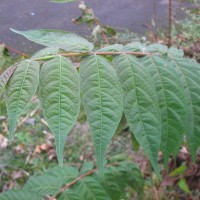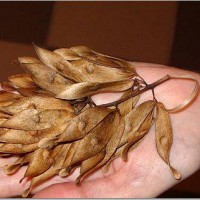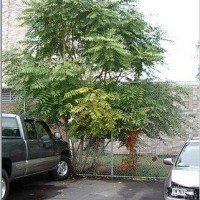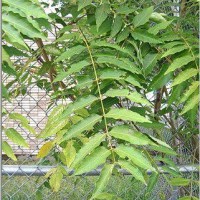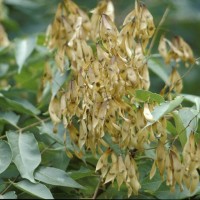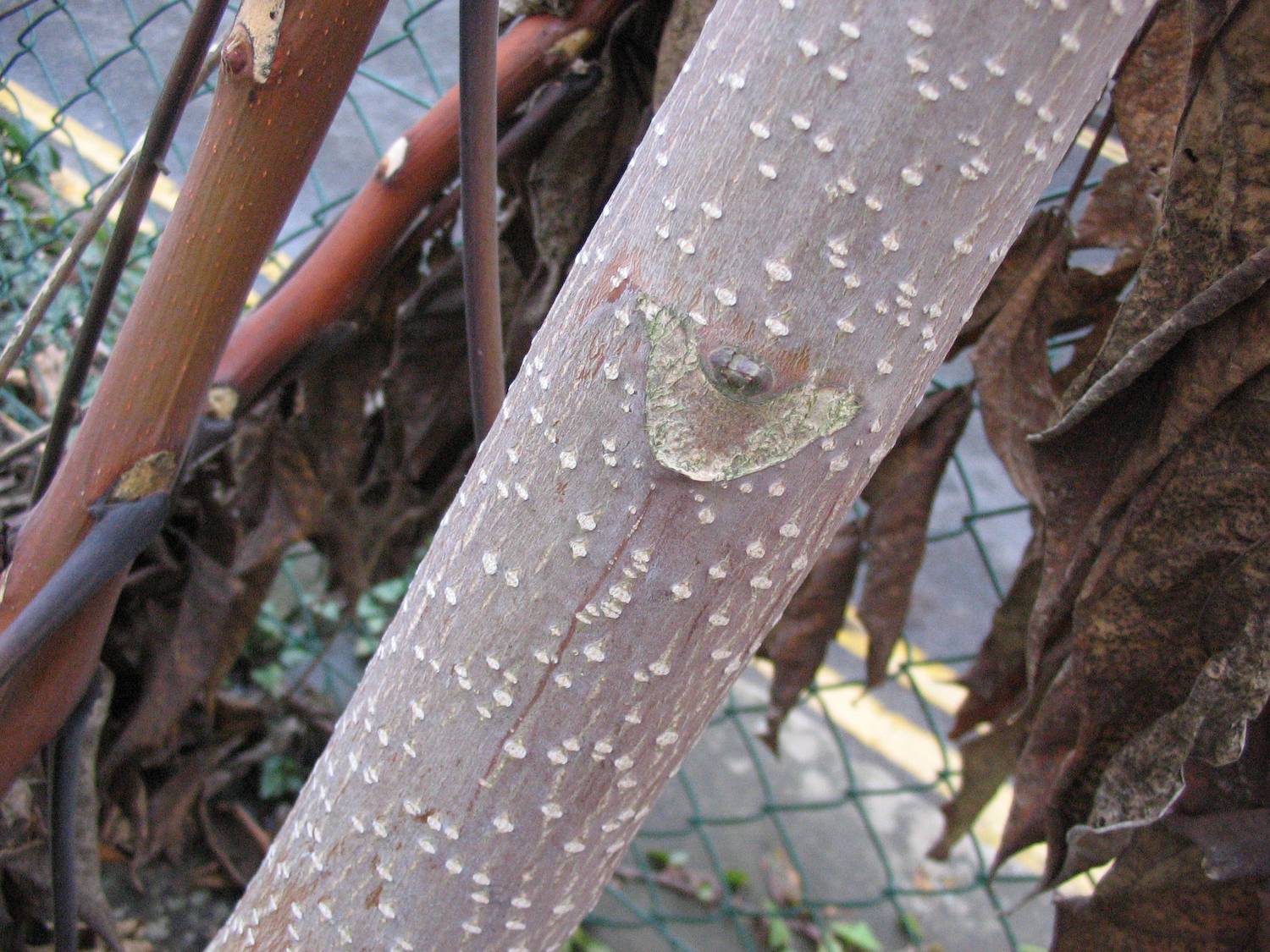
Tree-Of-Heaven - Ailanthus altissima
Expand and collapse the sections below by clicking on the title or + / - icons.
Short description of Ailanthus altissima, Tree-Of-Heaven
With large pinnate leaves, it resembles an ash, sumac or walnut. Less hairy than sumac, it has larger, more pinnate leaves than ash or walnut, with 11-25 pairs of leaflets, each 7-12 cm long. Unlike ash and walnut, it produces abundant sprouts from the roots. Broken twigs have a distinctive unpleasant smell.
Impact summary: Ailanthus altissima, Tree-Of-Heaven
Impact is currently low in GB. In warmer climates it can cause dermatitis, damages sewers and foundations, and crowds out native forest vegetation.
Habitat summary: Ailanthus altissima, Tree-Of-Heaven
Mainly in urban areas, especially near parks and gardens, and in London along railways. It is also planted in the grounds and parks of country houses.
Overview table
| Environment | Terrestrial |
|---|---|
| Species status | Non-Native |
| Native range | China South East perimeter |
| Functional type | Land plant |
| Status in England | Non-Native |
| Status in Scotland | Non-Native |
| Status in Wales | Non-Native |
| Location of first record | v.c.17 |
| Date of first record | 1935 |
Origin
Tree-of-heaven is native to China and north Vietnam.
First Record
It was introduced into cultivation in 1751, but not recorded from the wild until 1935.
Pathway and Method
Widely planted for ornament in SE GB during the 19th and early 20th centuries. It is tolerant of pollution and poor soils.
Species Status
At present, most English populations are confined to urban habitats of low conservation value. Tree-of-heaven is globally recognized as an invasive species, and listed by DAISIE as one of the 100 worst invasive species in Europe. It forms dense thickets by suckering, and suppresses other plant species via allelopathic effects. It has been reported to increase soil fertility.
Dispersal Mechanisms
Its winged seeds are dispersed up to 100 m by wind. Once established, it forms large clonal thickets by suckering from the roots. Suckers may appear up to 15 m from existing stems. It is sometimes sold by plant nurseries (25 entries in the RHS Plant Finder, 2010), and amateur gardeners are probably an still agent for transporting it over longer distances.
Reproduction
It is a dioecious species, with male and female flowers found on separate plants. Seed production in SE England and especially in London may be very large in warm summers, but may be low in N England and Scotland.
Known Predators/Herbivores
It is not significantly affected by insects in GB, or in much of its introduced range.
Resistant Stages
Seeds do not normally survive for more than a year, but have high viability in the spring following their production.
Habitat Occupied in GB
Its GB habitat is mainly urban, being abundant along railway lines in parts of London, and forming thickets elsewhere in parks, gardens and urban waste land. It is also planted in parkland in the countryside.
Well established in the London area. Although signified as established in Scotland by Stace et al. (2003), it probably persists there by clonal growth rather than reproduction from seed.
Environmental Impact
Its impact in GB is still relatively small, because it spreads mainly in man-made habitats of low conservation value. However, if the climate becomes warmer, it will increase rapidly in woods and parks. In warmer climates of southern Europe, it is highly invasive, excluding native vegetation by forming dense stands in woods and former grasslands. It maintains dominance by allelopathic exudates.
Health and Social Impact
The plant is mildly toxic; contact with the sap can produce dermatitis. More serious effects are rare. Tree-of-heaven is used extensively in Chinese traditional mecidine.
Economic Impact
It is valued as a street tree in some London boroughs, which spend money on shaping individual specimens. There are as yet few if any reports of economic damage in GB. In southern Europe and N America its roots damage sewers, pavements, archaeological remains and the foundations of buildings. Because of its strongly suckering habit, it is costly to eradicate.
Identification
Yancey, M. (2009) Invasive Exotic Plant Species: Ailanthus (Ailanthus altissima). Virginia Tech. http:pubs.ext.vt.edu420420-322420-322.html
Biology, ecology, spread, vectors
Kowarik, I. & Säumel, I. (2007) Biological Flora of Central Europe: Ailanthus altissima (Mill.) Swingle. Perspectives in Plant Ecology, Evolution and Systematics, 8, 207-237.
Management and impact
Gómez-Aparicio, L. & Canham, C.D. (2008) Neighbourhood analyses of the allelopathic effects of the invasive tree Ailanthus altissima in temperate forests. Journal of Ecology, 96, 447-458.
General
The best general reference is the Wikipedia article http:en.wikipedia.orgwikiAilanthus_altissima
A detailed but rather technical account is the EPPO draft factsheet http:www.eppo.orgQUARANTINEias_plants.htm
Basnou, C. and Vilà, M. (2006) DAISIE factsheet. http:www.europe-aliens.orgspeciesFactsheet.do?speciesId=16970#
Stace, C.A., Ellis, R.G., Kent, D.H. & McCosh, D.J., eds. (2003) Vice-county census catalogue of the vascular plants of Great Britain, the Isle of Man and the Channel Islands. Botanical Society of the British Isles, London.
Spotted this species?
Distribution map
View the Distribution map for Tree-Of-Heaven, Ailanthus altissima from NBN Atlas

Native range map
View an interactive native range map for Tree-Of-Heaven, Ailanthus altissima
Risk assessment
Risk assessment for Ailanthus altissima. See a full list of non-native species Risk assessments.
Legislation
This species is a Species of Special concern. Read more about Non-native species legislation.


